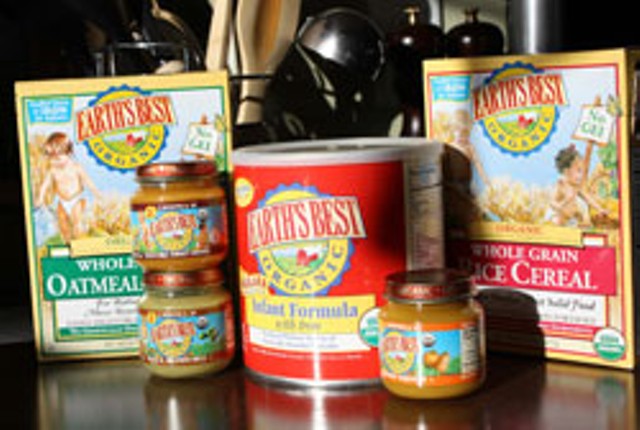Published April 21, 2010 at 4:33 a.m.
My wife and I never fixated on food purity until we had a baby on the way. Sure, we buy organic and eat low on the food chain when possible. But for much of our lives we’ve also consumed lots of edibles that are a few chemicals away from being lipstick or shoe polish. Think gummy worms, fast-food shakes and soft-serve ice cream.
That all changed when Stacy got pregnant. In no time, she treated her body as if it were a temple under siege by the Philistines, nixing anything that could harm the fetus. When Manya was born in September, Stacy was committed to breast-feeding her for at least a year, as recommended by our pediatrician, the maternity nurses, her lactation consultant and nearly all nutritional experts.
However, like many new mothers, Stacy had difficulty producing enough breast milk to keep pace with the baby’s voracious appetite. So, after she’d made several unsuccessful tries at boosting her milk production and decided she was averse to doing so with drugs, she reluctantly agreed to supplement with infant formula.
We chose an organic brand with local ties: Earth’s Best. Founded in 1985 by twin Vermonter brothers Ron and Arnie Koss, Earth’s Best was the first organic baby-food company in the United States. For more than a decade, its products were made under the strictest organic standards and challenged the wholesome reputations — and market shares — of such baby-food behemoths as Gerber and Beech-Nut.
Then, in 1996, the brothers lost control of the company — a story documented in their new book from White River Junction publisher Chelsea Green, The Earth’s Best Story: A Bittersweet Tale of Twin Brothers Who Sparked an Organic Revolution. Earth’s Best was sold to H.J. Heinz and, later, to its current owner, the Hain Celestial Group.
Today, Earth’s Best products still bear the “USDA Organic” label. And they’re perfect examples of how the definition of “organic” has become a battleground for politicians and a source of anxiety for consumers — especially parents.
That’s because, like nearly all infant formulas on store shelves today, Earth’s Best products contain the nutrient additives docosahexaenoic acid (DHA) and arachidonic acid (ARA). Together, these ingredients are marketed to consumers with claims that they make infant formula “as close as ever to breast milk” and foster healthier and smarter babies.
If the formula contained the two acids in their natural forms, that would be true. DHA and ARA are omega-3 and omega-6 fatty acids found in breast milk, and are essential to the healthy development of the brain, eyes and nervous system. Adults can get DHA and ARA by consuming fish, beef, egg yolks, nuts, flaxseed and canola oil.
However, the synthetic versions of DHA and ARA that are added to infant formulas may not live up to their hype, according to the Cornucopia Institute, a Wisconsin-based food- and farm-policy organization. In January 2008, it published a controversial report titled “Replacing Mother — Imitating Human Breast Milk in the Laboratory.” The report challenged the safety and efficacy of the two additives, as well as the legality of adding them to certified-organic products.
All synthetic DHA and ARA found in baby formulas sold in the United States, conventional or organic, are manufactured by one company: Martek Biosciences Corporation of Columbia, Md. According to the Cornucopia report, Martek produces synthetic DHA and ARA by extracting oils from laboratory-grown algae and soil fungi using hexane, a byproduct of gasoline refining, a chemical solvent and a neurotoxin. These “novel” forms of DHA and ARA — known by their patent names DHASCO and ARASCO — are now being added to other foods and nutritional supplements marketed to children and adults.
Charlotte Vallaeys is the farm- and food-policy analyst who wrote the Cornucopia Institute report. As she explains, DHASCO and ARASCO are chemically different from the DHA and ARA found in human breast milk. Moreover, she tells Seven Days that studies published after her report confirm her initial findings that babies fed infant formula containing DHASCO and ARASCO show no evidence of improved cognitive or behavioral development, and only limited benefits in visual acuity.
In 2001, the U.S. Food and Drug Administration granted DHASCO and ARASCO the official status of “GRAS” — or “generally recognized as safe.” However, Vallaeys asserts that the FDA never actually confirmed the safety of these products. In fact, she adds, a panel of independent scientists convened by the Institute of Medicine determined that premarket safety tests of these oils were inadequate.
The Cornucopia Institute further alleges that, since 2002, when the two synthetics were placed on the market, the FDA has received “hundreds” of reports of adverse reactions in infants who consumed DHA/ARA-supplemented formulas, including at least 98 traceable to those additives. They include explosive diarrhea, vomiting, bloating, gastrointestinal pain, rashes and seizures.
“We have emails from these women who, in less than 24 hours or even after one feeding [without DHA and ARA] — the severe symptoms went away,” notes Mark Kastel, a senior policy analyst at the Cornucopia Institute. Although the number of those problems appears to be small, the Cornucopia Institute has asked the FDA and Federal Trade Commission to require warning labels on infant formula containing these additives.
Kastel also notes that the addition of DHA and ARA makes infant formula more expensive to parents — by 15 to 30 percent, according to his figures. It also costs taxpayers, who subsidize infant formula for low-income mothers through the federal Women, Infants and Children (WIC) program.
How did a food additive made using an industrial solvent find its way into organic foods? That’s a story unto itself. But, according to an article published in the July 3, 2009, Washington Post, a deputy USDA administrator appointed by the Bush administration overruled her staff’s concern about DHA/ARA after she was contacted by a lawyer for the formula manufacturers. That decision, which the Cornucopia Institute discovered through Freedom of Information Act requests, is now the subject of a formal legal complaint.
“This is, in essence, one big marketing scheme,” Kastel concludes. “It’s causing kids to get sick with virtually no scientific evidence that it does them any good.”
Such allegations stopped my wife and me dead in our tracks. While everyone, including formula manufacturers, agrees that “breast is best” for babies, some mothers cannot breast-feed for any of a multitude of reasons. What are our options, when all the organic formula brands on the market contain Martek DHA and ARA? Our lactation consultant won’t even recommend a brand; her profession’s code of ethics doesn’t allow it.
A spokesperson for Earth’s Best didn’t get back to Seven Days by press time. However, a Martek representative was more than willing to offer her assessment of the Cornucopia Institute’s report.
It’s nonsense, says Martek spokesperson Cassie France-Kelly, who’s “very familiar” with the report and its “outlandish claims.” Moreover, she adds, it was “authored by someone with a degree in divinity.” (That’s true: Vallaeys has a master’s degree from Harvard in theological studies — and another in nutrition from the Friedman School of Nutrition Science and Policy at Tufts.)
“Over 55 million babies worldwide have taken this product … and there [have] never been any adverse effects” attributable to Martek’s DHA and ARA in the eight years it’s been on the market, France-Kelly asserts. And, with more than 4 million new babies in 75 countries starting to consume the product annually, if there were safety issues, she says, they’d be readily apparent by now.
France-Kelly admits that the research on the benefits of synthetic DHA/ARA in infant formulas is “mixed.” However, she claims there’s “a growing body of scientific evidence” showing that babies who receive DHA/ARA-supplemented formulas have better cognitive and visual development to age 8 than those who eat nonsupplemented ones. For babies who are fed formula, she adds, the World Health Organization recommends those brands containing DHA and ARA.
What about the claim that the substances are “organic”? France-Kelly says the hexane-extraction process is actually the same one that’s been used for more than 50 years to make cooking oils, and those products contain no hexane residues. Moreover, she notes, as many as 5 percent of the ingredients in certified “organic” foods may be nonorganic “accessory nutrients” when there’s no organic substitute.
France-Kelly won’t comment on the specific controversy surrounding the certification of a hexane-derived nutrient as organic. “That’s a regulatory issue with the National Organic Program,” she says. “We, as an ingredient company, like our customers Earth’s Best and all the others, adhere to all current regulations.”
As it happens, the senior vice president from Quality Assurance International who certifies Earth’s Best products as organic — and serves on the National Organic Standards Board (NOSB) that decides which ingredients are allowed in organic foods — is Joe Smillie of South Burlington.
Smillie is also familiar with the Cornucopia report, but he won’t comment publicly on it. He will say, however, that “Earth’s Best is one of the best in the business” for testing its products for chemical residues, and that the food the company puts out is “remarkably free of the stuff.”
Of course, Smillie also acknowledges that organic certification isn’t just about what shows up in the food but about how it’s produced.
“Hexane is horrific,” he says. “There’s no two ways about it.”
Next week the NOSB will issue a statement on its “current thinking” about accessory nutrients such as DHA and ARA, with a final ruling expected by this fall. In the interim, all the assertions made by Martek and the Cornucopia Institute will be weighed very carefully and publicly, Smillie says.
What do the founders of Earth’s Best think of all this? Ron Koss, who still lives in Montpelier, isn’t involved with the company anymore and isn’t familiar with the Cornucopia Institute’s report. And, since Earth’s Best didn’t make infant formula when he and his brother ran it, Koss says questions about DHA and ARA fall outside his area of expertise.
“But if Arnie and I had been involved in infant-formula development, we would have weighed this very carefully,” says Koss, who currently develops other food products, including a nutritional bar used in developing countries for people who are malnourished. “People who are in these companies need those organic standards. Otherwise, it’s the Wild West out there.”
While the NOSB struggles to lay down the law on the organic frontier, my wife and I are sticking with Earth’s Best solid baby foods, which don’t have DHA or ARA. My wife has redoubled her effort to breast-feed, as nature intended — and still eats the occasional maple creemee and strawberry shake.
More By This Author
Speaking of...
-

Q&A: Howard Fisher Delivers Meals on Wheels With a Side of Good Cheer
Dec 20, 2023 -

Video: Howard Fisher Delivers Meals on Wheels
Dec 14, 2023 -

Q&A: Alexis Dexter Rescued 57 Shelter Cats During the July Flood
Sep 13, 2023 -

Video: Two Months After the Flood, Alexis Dexter Rebuilds Kitty Korner Café in Barre and Continues to Rescue Cats
Sep 7, 2023 -

Vermont's Childcare System Isn't Working for Providers or Parents. They Hope Help Is on the Way.
Jan 11, 2023 - More »
Comments
Comments are closed.
From 2014-2020, Seven Days allowed readers to comment on all stories posted on our website. While we've appreciated the suggestions and insights, right now Seven Days is prioritizing our core mission — producing high-quality, responsible local journalism — over moderating online debates between readers.
To criticize, correct or praise our reporting, please send us a letter to the editor or send us a tip. We’ll check it out and report the results.
Online comments may return when we have better tech tools for managing them. Thanks for reading.














































